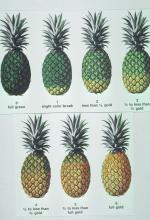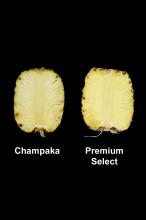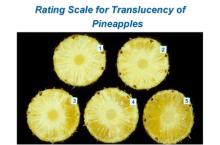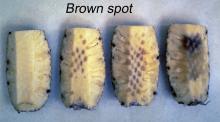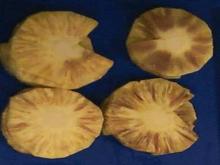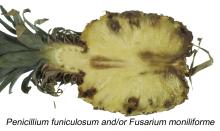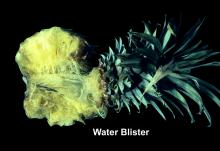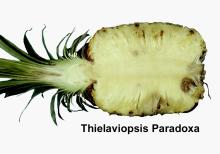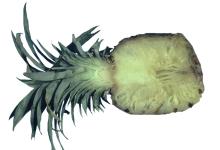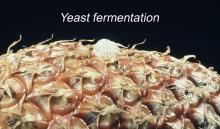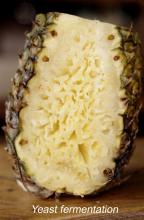Índices de madurez
Change of shell color from green to yellow at the base of the fruit. Pineapples are non-climacteric fruits and should be harvested when ready to eat. A minimum soluble solids content of 12% and a maximum acidity of 1% will assure minimum flavor acceptability by most consumers.
- Uniformity of size and shape
- Firmness
- Freedom from decay
- Freedom from sunburn, sunscald, cracks, bruising, internal breakdown, endogenous brown spot, gummosis, and insect damage
- Tops (crown leaves): green color, medium length, and straightness
- Range of soluble solids = 11-18%; titratable acidity (mainly citric acid) = 0.5-1.6%; and ascorbic acid = 20-65mg/100g fresh weight, depending on cultivar and ripeness stage
Manejo y almacenamiento poscosecha
10-13°C (50-55°F) for partially-ripe pineapples.
7-10°C (45-50°F) for ripe pineapples.
| Temperature | 7°C (45°F) | 10°C (50°F) | 13°C (55°F) | 15°C (59°F) | 20°C (68°F) |
| ml CO2/kg·hr | 2-4 | 3-5 | 5-8 | 8-10 | 15-20 |
To calculate heat production multiply ml CO2/kg·hr by 440 to get Btu/ton/day or by 122 to get kcal/metric ton/day.
Exposure of pineapples to ethylene may result in slightly faster degreening (loss of chlorophyll) without influencing internal quality. Pineapples must be picked when ripe because they do not continue to ripen after harvest.
85-90%
Less than 0.2 µl C2H4/kg·hr at 20°C (68°F)
- 3-5% O2 and 5-8% CO2
- Benefits of CA include delayed senescence and reduced respiration rate
- Postharvest life potential: 2-4 weeks in air and 4-6 weeks in CA 10°C (50°F), depending on cultivar and ripeness stage
- Exposure to O2 levels below 2% and/or CO2 levels above 10% should be avoided because of the potential for development of off-flavors
- Waxing may be used to modify O2 and CO2 concentrations within the fruit enough to reduce incidence and severity of endogenous brown spot
Desórdenes
Chilling injury. Exposure of pineapples to temperatures below 7°C (45°F) results in chilling injury. Ripe fruits are less susceptible than unripe or partially-ripe fruits. Symptoms include dull green color when ripened (failure to ripen properly), water-soaked flesh, darkening of the core tissue, increased susceptibility to decay, and wilting and discoloration of crown leaves.
Endogenous Brown Spot (EBS) or Black Heart. EBS is usually associated with exposure of pineapples before or after harvest to chilling temperatures, e.g. below 7°C (45°F) for one week or longer. Symptoms are water-soaked, brown areas that begin as spots in the core area and enlarge to make the entire center brown in severe cases. Waxing is effective in reducing chilling injury symptoms. A heat treatment at 35°C (95°F) for one day has been shown to ameliorate EBS symptoms in pineapples transported at 7°C (45°F) by inhibiting activity of polyphenol oxidase and consequently tissue browning.
Thielaviopsis rot (black rot, water blister). Caused by Thielaviopsis paradoxa, may start at the stem and advance through most of the flesh with the only external symptom being slight skin darkening due to watersoaking of the skin over rotted portions of the flesh. As the flesh softens, the skin above readily breaks under slight pressure.
Yeast fermentation. Caused by Saccharomyces spp, is usually associated with overripe fruit. The yeast enters the fruit through wounds. Fruit flesh becomes soft and bright yellow and is ruptured by large gas cavities.
Control Strategies
- Careful handling to minimize mechanical injuries
- Prompt cooling and maintenance of optimum temperature and relative humidity throughout postharvest handling operations
- Application of fungicides, such as thiabendazole (TBZ)



